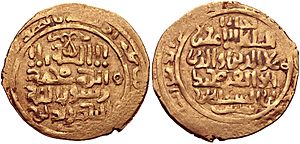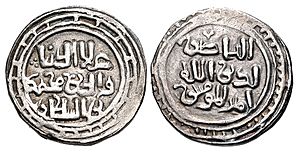Muhammad II of Khwarazm facts for kids
Quick facts for kids Muhammad II |
|||||
|---|---|---|---|---|---|
| The Second Alexander | |||||

Gold dinar of Ala ad-Din Muhammad II, struck at the Bukhara mint
|
|||||
| Shah of Khwarezm | |||||
| Reign | 1200–1220 | ||||
| Coronation | 1200 | ||||
| Predecessor | Tekish | ||||
| Successor | Jalal al-Din Mangburni | ||||
| Co-reignt | Terken Khatun | ||||
| Born | 1169 | ||||
| Died | 1220 (aged 50–51) Abaskun, Hyrcania Region, near Caspian Sea, now Iran |
||||
| Spouse | Ay Chichek Khatun | ||||
| Issue | Jalal ad-Din Manguberdi | ||||
|
|||||
| House | House of Anushtegin | ||||
| Father | Tekish | ||||
| Mother | Terken Khatun | ||||
| Religion | Sunni Islam | ||||
Ala ad-Din Muhammad II was a powerful ruler, known as the Shah of the Khwarazmian Empire. He ruled from 1200 to 1220. His family came from a Turkic background. His ancestor, Anushtegin Gharchai, was a governor of a small area called Khwarizm. Muhammad II is mostly remembered for his actions that led to the Mongol conquest of the Khwarazmian Empire. This event caused his empire to be completely destroyed.
Muhammad II's Rule
After his father, Tekish, passed away, Muhammad became the new Shah. Soon after he took power, his lands were attacked. Two brothers from the Ghurid Empire, Ghiyath al-Din Ghori and Mu'izz al-Din, invaded his territory. They quickly moved their armies into a region called Khorasan.
In 1203, Ghiyath al-Din died. Muhammad II saw this as a chance to attack the Ghurid Empire. He tried to capture their city of Herat. However, Mu'izz al-Din pushed him back and then chased him all the way to Muhammad's capital city, Gurganj.
Muhammad desperately asked for help from the Kara-Khitan Khanate. They sent an army to support him. Because of this new threat, Mu'izz al-Din had to stop his attack and retreat. On his way back, he was defeated in a battle in 1204. Mu'izz al-Din was later killed in 1206, which caused a civil war in the Ghurid Empire.
During this civil war, Muhammad II took advantage of the situation. He invaded the Ghurid lands again. He captured cities like Balkh and Tirmidh. However, during one of his invasions, he was captured by the Kara-Khitan Khanate.
Thirteen months later, Muhammad was set free. He immediately went back to fighting the Ghurids. He captured Herat and then moved into the main Ghurid territory of Ghur. He even captured the Ghurid ruler, Ghiyath. Ghiyath then agreed to accept Muhammad's authority.
Muhammad II continued to expand his empire. In 1207, he captured Samarkand from the Kara Khitay. He also took Tabaristan in 1210 and Transoxiana from the Western Karakhanids. He conquered Tashkent and Fergana. Regions like Makran and Balochistan were also added to his empire. Other rulers, like the Atabegs of Azerbaijan, became his loyal subjects in 1211.
He finally defeated the Western Karakhanids in 1212 and the Ghurids in 1215. He took over all their remaining lands. In 1212, the city of Samarkand rebelled. Many Khwarezmians living there were killed. In return, Muhammad attacked the city and executed many citizens of Samarkand.
By 1217, Muhammad II had conquered a vast area. His empire stretched from the Jaxartes river to the Persian Gulf. He declared himself Shah and wanted the caliph in Baghdad to officially recognize him. But the caliph, an-Nasir, refused his demand. So, Ala ad-Din Muhammad gathered an army and marched towards Baghdad to remove the caliph from power. However, as his army crossed the Zagros Mountains, they were caught in a terrible snowstorm. Thousands of soldiers died. With his army weakened, Muhammad had to turn back home.
The Empire's Fall
In 1218, a small group of Mongols crossed into Muhammad's lands. They were chasing an enemy general who had escaped. After catching the general, Genghis Khan tried to make contact with Shah Muhammad. Genghis Khan had recently conquered large parts of China. He wanted to start trade with Muhammad's empire.
However, Shah Muhammad had heard exaggerated stories about the Mongols. He thought Genghis Khan's offer was just a trick to invade his land. Genghis Khan sent messengers to Khwarezm to show he wanted peaceful trade. Some reports say there were 100 Muslim merchants with one Mongol leader. Others say there were 450 messengers.
Shah Muhammad's uncle, a governor named Inalchuq, openly accused these messengers of being spies. Their valuable goods were taken, and the messengers were arrested.

Genghis Khan tried to keep peace. He sent three more men to the Shah. He wanted the Shah to say he knew nothing about the governor's actions. He also asked the Shah to hand over the governor for punishment. But the Shah executed these messengers. Some sources say one man was killed, others say all three. Then, he immediately ordered all the Mongol merchants and their goods to be seized.
These actions made Genghis Khan furious. He decided to attack. In 1219, a huge Mongol army, possibly 100,000 to 150,000 men, crossed the Jaxartes river. They attacked and destroyed many cities, including Samarkand, Bukhara, and Otrar. Muhammad's capital city, Urgench, was also destroyed soon after.
Death of Muhammad II
Ala ad-Din Muhammad fled from the Mongols. He tried to find safety in different parts of Khorasan. Weeks later, he died from a lung illness called pleurisy. He passed away on an island in the Caspian Sea, near a port called Abaskun.
See also
 In Spanish: Mohamed II de Corasmia para niños
In Spanish: Mohamed II de Corasmia para niños


